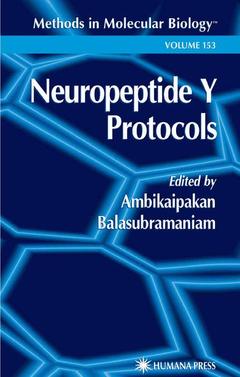Neuropeptide Y Protocols, Softcover reprint of the original 1st ed. 2000 Methods in Molecular Biology Series, Vol. 153
Langue : Anglais
Coordonnateur : Balasubramaniam Ambikaipakan

The observation that neuropeptide Y (NPY) is the most abundant peptide present in the mammalian nervous system and the finding that it elicits the most powerful orexigenic signal have led to active investigations of the properties of the NPY family of hormones, including peptide YY (PYY) and pancreatic polypeptide (PP). Nearly two decades of research have led to the identification of several NPY receptor subtypes and the development of useful receptor selective ligands. Moreover, these investigations have imp- cated NPY in the pathophysiology of a number of diseases, including feeding disorders, seizures, memory loss, anxiety, depression, and heart failure. Vigorous efforts are therefore continuing, not only to understand the bioche- cal aspects of NPY actions, but also toward developing NPY-based treatments for a variety of disorders. To facilitate these efforts, it was decided to produce the first handbook on NPY research techniques as part of the Methods in Molecular Biology Series. In compiling Neuropeptide Y Protocols, I have gathered contributions on techniques considered critical for the advancement of the NPY field from experts in various disciplines. Each chapter starts with a brief introduction, with Materials and Methods sections following. The latter sections are presented in an easy to follow step-by-step format. The last section of the chapter, Notes, highlights pitfalls and the maneuvers employed to overcome them. This information, not usually disseminated in standard research pub- cations, may prove extremely useful for investigators employing these te- niques in NYP research.
Cloning Techniques.- Cloning Neuropeptide Tyrosine cDNA.- Human Y1/Y5 Receptor Gene Cluster.- Human Type 2 Neuropeptide Y Receptor Gene.- Y4 Receptor in Different Species.- NeuropeptideYY5 Receptor Expression.- Homology-Based Cloning Methods.- Production of Transgenic and Knock-Out Models.- Developing Transgenic NeuropeptideY Rats.- NeuropeptideYY1 Receptor-Deficient Mice.- Antisense Technology.- Antisense Oligonucleotide Approach to Study NPY-Mediated Feeding Signal Transduction.- A G?i RNA-Antisense Expression Strategy to Investigate Coupling of Peptide YY/Neuropeptide Y Receptor to G?i.- NPY Y5 Receptor Subtype.- NPY Antisense Oligodeoxynucleotides to Study the Actions of NPY.- Techniques to Study Tissue Distribution of mRNA.- Localization of Y-Receptor Subtype mRNAs in Rat Brain by Digoxigenin Labeled In Situ Hybridization.- Central Y4 Receptor Distribution.- Combining Non-Isotopic Localization of NPY mRNA with Immunocytochemistry.- Miscellaneous Techniques.- Y Receptors Characterized by RT-PCR.- Quantification of NPY mRNA by Ribonuclease Protection Assay.- Radioligand Binding Studies.
Includes supplementary material: sn.pub/extras
Date de parution : 08-2013
Ouvrage de 246 p.
15.2x22.9 cm
Date de parution : 07-2000
Ouvrage de 246 p.
15.5x23.3 cm
Thème de Neuropeptide Y Protocols :
© 2024 LAVOISIER S.A.S.



